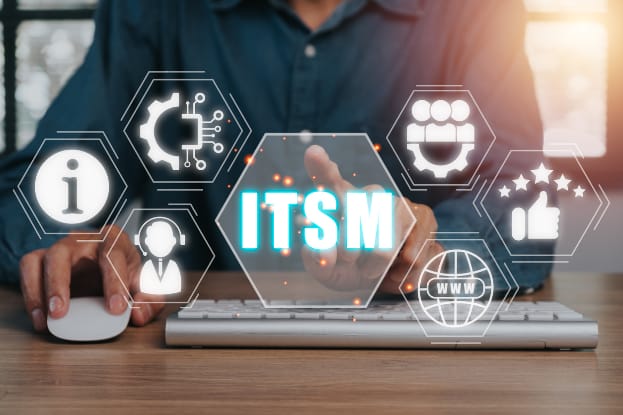In today’s fast-paced, technology-driven world, businesses are increasingly reliant on IT services to maintain their operations. As organizations grow and adapt to new technological advancements, so too must their approach to managing IT services. IT Service Management (ITSM) has evolved significantly over the years, transitioning from simple service desks to complex, integrated frameworks designed to optimize both IT performance and customer experience.
This blog will explore the evolution of ITSM, examining key trends shaping the field, as well as best practices that can help organizations achieve more effective IT service delivery.
What is IT Service Management (ITSM)?
At its core, ITSM is a set of practices, policies, and procedures that organizations use to design, deliver, manage, and improve the way IT services are provided to users. ITSM is essential in ensuring that IT aligns with business goals and that customers, whether internal employees or external clients, experience high levels of service satisfaction.
Historically, ITSM was focused on reactive, break/fix models, but it has grown into a more strategic discipline that prioritizes proactive service delivery, automation, and continuous improvement.
The Evolution of ITSM –
- The Early Days: Reactive Support and Incident Management –
In the early stages of ITSM, the focus was primarily on providing reactive support. This typically involved managing incidents and service requests in an ad-hoc manner. IT departments were often seen as a cost center, and the role of IT was largely limited to ensuring that systems stayed operational. Support teams worked to fix issues as they arose, often without formalized processes or structures.
ITIL (Information Technology Infrastructure Library) emerged in the 1980s, providing a framework to standardize IT service management practices. ITIL’s focus was on service desk management, incident management, and problem management, aiming to minimize disruptions and ensure business continuity. However, many organizations still operated with a siloed, manual approach, where communication between IT teams and business units was minimal.
- The Rise of ITIL: Standardization and Process Frameworks –
In the 1990s and early 2000s, ITIL began to gain traction as businesses recognized the need for a more structured, process-driven approach to managing IT services. ITIL provided a comprehensive framework to standardize IT service delivery, defining core processes such as:
- Incident Management: Resolving IT disruptions to restore normal service quickly.
- Problem Management: Identifying and eliminating the root causes of incidents.
- Change Management: Ensuring changes to IT infrastructure are made with minimal disruption.
This era saw the development of service catalogs, service level agreements (SLAs), and a stronger emphasis on IT processes as part of overall business strategy. IT departments began shifting from reactive, break/fix operations to more proactive, process-based models.
- The Cloud and ITSM as a Service –
With the rise of cloud computing and Software-as-a-Service (SaaS), ITSM has continued to evolve. Cloud-based ITSM platforms allow organizations to implement IT service management practices without the need for heavy on-premises infrastructure. These platforms offer scalability, flexibility, and cost efficiency while improving the overall user experience.
Cloud-based ITSM tools also provide greater access to real-time data analytics, giving organizations the ability to monitor service performance, identify trends, and implement proactive measures. Additionally, ITSM-as-a-Service (ITSMaaS) has emerged as a solution for businesses looking for simplified, outsourced IT service management solutions.
Key Trends Shaping ITSM –
- AI and Machine Learning in ITSM –
Artificial Intelligence (AI) and machine learning are increasingly being integrated into ITSM tools to enhance automation, improve incident resolution times, and provide predictive analytics. AI-driven chatbots and virtual agents can handle routine support tickets, assist users with self-service, and provide 24/7 assistance. These technologies enable IT teams to focus on more complex issues while improving the user experience.
- Service-Oriented ITSM –
Rather than focusing solely on internal IT processes, modern ITSM is adopting a more service-oriented approach. The focus is on delivering value to customers (internal or external) and aligning IT services with business outcomes. Service delivery models such as IT as a Service (ITaaS) are gaining popularity, where IT departments function more like service providers to the rest of the business.
- Shift to Proactive IT Management –
ITSM is increasingly focusing on preventing incidents before they occur. Predictive analytics, powered by AI, can help identify potential issues by analyzing patterns in data from various systems. By adopting a more proactive approach, IT departments can reduce downtime, enhance service availability, and improve the overall user experience.
- Collaboration and Cross-Departmental Integration –
The integration of ITSM with other business functions like HR, customer service, and facilities management is becoming more prevalent. By sharing data and processes across departments, organizations can improve service delivery and ensure that all parts of the business are aligned in terms of IT needs.
Conclusion –
The evolution of IT Service Management reflects the ongoing transformation of IT from a cost center to a strategic enabler of business success. As ITSM continues to evolve, it will embrace automation, artificial intelligence, and more integrated approaches to service delivery. By following the latest trends and best practices, organizations can ensure they remain at the forefront of IT service management, delivering exceptional service while aligning IT with business goals and driving overall success.

